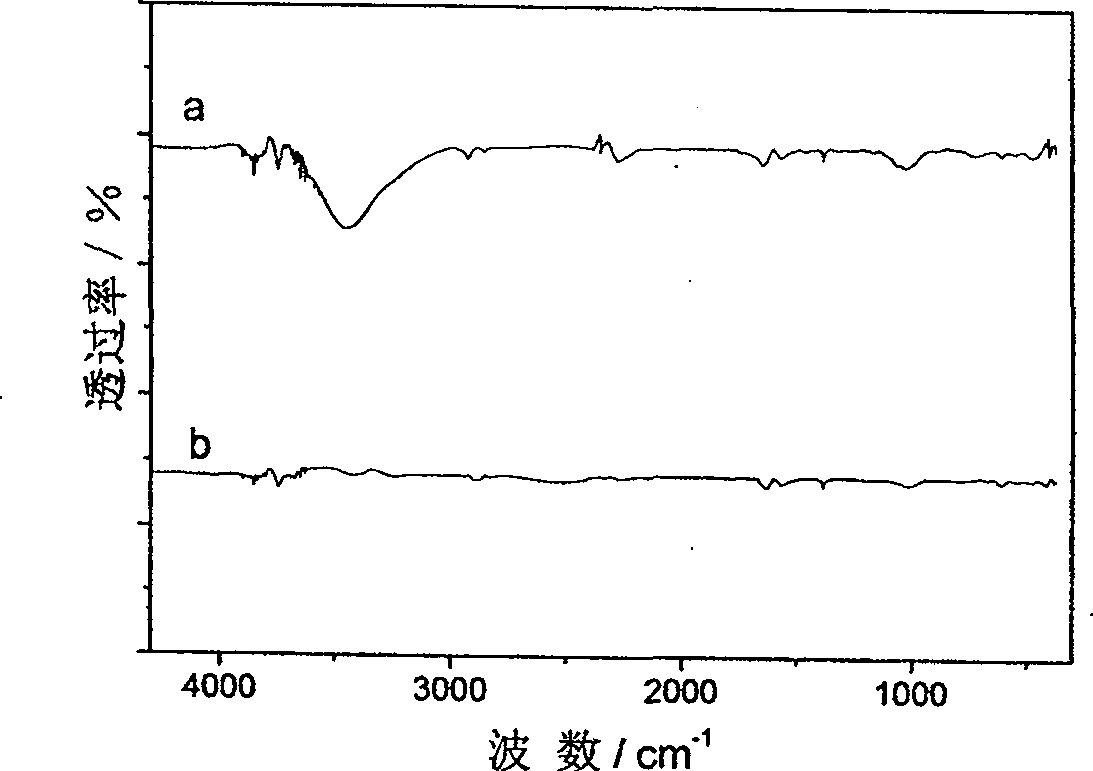Method of improving chemical activity of carbon nano-tube
A carbon nanotube, chemically active technology, applied in nanotechnology, nanotechnology, nanostructure manufacturing, etc., can solve the problems of limited improvement of carbon nanotube chemical activity, complicated operation, and inflexible control, and achieve complete removal of metal particles. , strong oxidation selectivity, good purification effect
- Summary
- Abstract
- Description
- Claims
- Application Information
AI Technical Summary
Problems solved by technology
Method used
Image
Examples
Embodiment 1
[0027] Use cellulose membrane as the carbon nanotube support membrane, cut it into a rectangle of 1cm×3cm, wear a 50mm×0.1mm platinum wire on it, one end is in direct contact with the carbon nanotube, and the other end sticks out of the cellulose membrane , as a wire; take 0.2g of single-walled carbon nanotubes, mix them into a paste with 0.5mL of ultrapure water, and evenly spread it on the surface of the cellulose membrane, cover it with platinum wires, and the thickness of the carbon nanotube layer is about 0.5mm. (25°C) and dried for 3 hours to make anode I.
[0028] Add 1.0mol / L KCl solution into the constant potential electrolytic cell as the electrolyte, place the anode I in the constant potential electrolytic cell, and the carbon nanotube film is completely submerged below the liquid surface. The platinum sheet electrode was used as the cathode, the saturated calomel electrode was used as the reference electrode, the anode potential was set to 2.00V, and the constant p...
Embodiment 2
[0030] Use polyethylene film as the carbon nanotube support film, cut it into a rectangle of 2cm×10cm, wear a 150mm×0.1mm platinum wire on it, one end is in direct contact with the carbon nanotube, and the other end extends out of the polyethylene film , as a wire; take 3.0g of double-walled carbon nanotubes, mix them into a paste with 3.0mL N,N-dimethylformamide, apply it evenly on the surface of polyethylene film, cover the bottom with platinum wire, and the thickness of the carbon nanotube layer is About 1.2mm, dried in an oven at 60°C for 2 hours to make anode II.
[0031] Add 2.0mol / LNH to the constant potential electrolytic cell 4 Cl solution is used as the electrolyte, and the anode II is placed in the constant potential electrolytic cell, and the carbon nanotube film is completely submerged below the liquid surface. The platinum sheet electrode was used as the cathode, the saturated calomel electrode was used as the reference electrode, the anode potential was set to ...
Embodiment 3
[0033] Teflon film is used as the carbon nanotube support film, which is cut into a square of 10cm×10cm, and a 150mm×0.1mm platinum wire is passed through the middle of the film, one end is in direct contact with the carbon nanotube, and the other end extends out of the Teflon film as Wire: take 5.0g of multi-walled carbon nanotubes, mix them with 3.0mL of carbon tetrachloride to form a paste, evenly spread it on the surface of the Teflon film, cover it with platinum wire, the thickness of the carbon nanotube layer is about 2.0mm, and put it in an oven at 80°C Dry in medium for 2h to make anode III.
[0034] Add 2.5mol / L NaCl solution into the constant potential electrolytic cell as the electrolyte, place 10 anodes III in parallel in the constant potential electrolytic cell, and the carbon nanotube film is completely submerged below the liquid surface. The platinum sheet electrode was used as the cathode, the saturated calomel electrode was used as the reference electrode, the...
PUM
| Property | Measurement | Unit |
|---|---|---|
| area | aaaaa | aaaaa |
| thickness | aaaaa | aaaaa |
Abstract
Description
Claims
Application Information
 Login to View More
Login to View More - R&D
- Intellectual Property
- Life Sciences
- Materials
- Tech Scout
- Unparalleled Data Quality
- Higher Quality Content
- 60% Fewer Hallucinations
Browse by: Latest US Patents, China's latest patents, Technical Efficacy Thesaurus, Application Domain, Technology Topic, Popular Technical Reports.
© 2025 PatSnap. All rights reserved.Legal|Privacy policy|Modern Slavery Act Transparency Statement|Sitemap|About US| Contact US: help@patsnap.com

